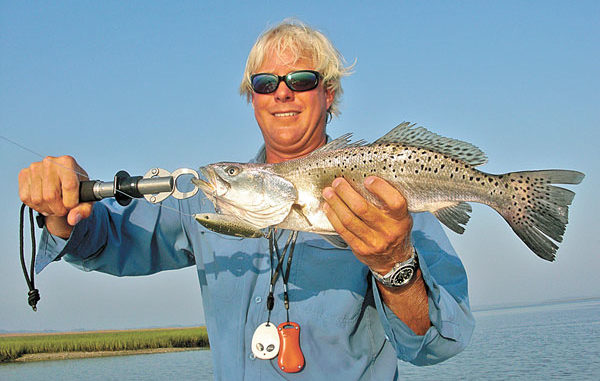
Capt. Brad Rumph operates Sonny Boy Charters, which hints at the local dialect that’s a part of the Wadmalaw, Edisto and Johns Island area. Rumph, a Johns Island native, has fished out of Bohicket Marina for years and has built up a storehouse of knowledge on his own, as well as picking up plenty from local legends such as Capt. Harry Limehouse and Capt. Sidi Limehouse.
A “Sonny Boy” might say that the early bird gets the worm, and that’s exactly what Rumph promotes when he’s fishing during the hottest part of the summer. An early departure from the docks gives anglers a better chance to catch fish before the sun rises.
Before the sun rises?
“Lots of vacationers don’t want to get up early while on vacation, but I try to get them fired up via telephone and tell them that the topwater bite will make you a changed man,” he said.
Rumph (843.708.1486) loves to fish topwater lures like the Rapala Skitterwalk in the trout pattern or the Bomber Badonk-A-Donk.
“About 80 percent of my clients are believers after they catch a few topwater fish, and while they still like catching fish using live bait, the thrill of the topwater strike is best,” he said.
Live bait is often employed after the sun begins to shine down on the water’s surface, which greatly reduces the topwater bite. Generally speaking, there is a window of about an hour-and-a-half after dawn when the topwater bite is on for all three species of the “inshore slam” — speckled trout, redfish and flounder.
Flounder are not always targeted with topwater lures, but they are often a by-catch from casting into shallow waters near mud banks and shell points. One of the simple truths of fishing is that if you’re not getting hung up from time to time, then you’re are not casting close enough to the structure that tends to hold fish.
Rumph prefers to fish next to what he calls a “bass-flats ecosystem” that consists of green marsh, oyster mounds, shell points, shallow waters, plenty of bait and wading birds. The first cast in the pre-dawn humid haze one morning resulted in a topwater strike that was so shocking it served as a wake-up call to the angler who was reeling in the line. Luckily, a trout slammed the lure a second time, and this time, the wide-eyed angler got him hooked up.
August is likely the hottest month on the calendar, so it’s important to get on the water early when fish are still active. After being part of a trip that featured a 5-pound gator trout, a 30-inch, 11-pound redfish, a 3½-pound trout and a 9-pound redfish, if “Sonny Boy” Rumph wants you at the ramp early to catch some topwater trout, you might want to listen up!
Rumph only smiles when a fish takes a swipe at a topwater lure but does not connect. “I love to see them go after it like that, and while customers might feel a little bit of frustration, I know that until that sun gets too high, there is a good chance that another fish is going to slam their lure and erase the missed strike with the memory of a redemption,” he said.
Rumph has some concerns about the number of smaller trout he’ll find later in the fall, due to this past winter’s extremely cold weather. He’s seen enough large trout this summer to know that the bigger fish were not affected by the cold, and that they are as feisty as ever.
The last thing that some vacationing fishermen want to do is clean fish, so catch-and-release is practiced quite often. Rumph employs a rubber Frabill landing net make sure that a fish’s slime coat isn’t damaged as it often is with a coated nylon net. You’ve got to protect specks if you want them to crash your topwater baits on a regular basis.



Be the first to comment